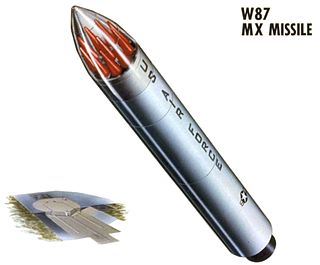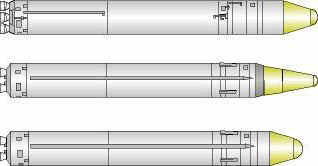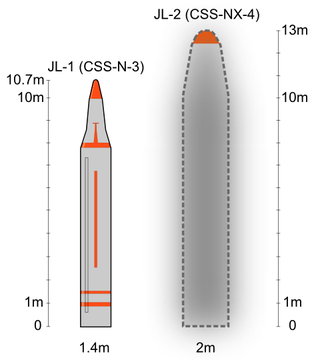Related Research Articles

A multiple independently targetable reentry vehicle (MIRV) is an exoatmospheric ballistic missile payload containing several warheads, each capable of being aimed to hit a different target. The concept is almost invariably associated with intercontinental ballistic missiles carrying thermonuclear warheads, even if not strictly being limited to them. An intermediate case is the multiple reentry vehicle (MRV) missile which carries several warheads which are dispersed but not individually aimed. Only the United States, the United Kingdom, France, Russia and China are currently confirmed to have deployed MIRV missile systems. Pakistan is developing MIRV missile systems. Israel is suspected to possess or be in the process of developing MIRVs.

The Dongfeng series, typically abbreviated as "DF missiles", are a family of short, medium, intermediate-range and intercontinental ballistic missiles operated by the Chinese People's Liberation Army Rocket Force.

The SY, and HY series were early anti-ship cruise missiles (ASCM) developed by the People's Republic of China from the Soviet P-15 Termit missile. They entered service in the late 1960s and remained the main ASCMs deployed by the People's Liberation Army Navy through the 1980s. The missiles were used by the PRC and export customers to develop land-attack missiles.

The Strategic Rocket Forces of the Russian Federation or the Strategic Missile Forces of the Russian Federation is a separate-troops branch of the Russian Armed Forces that controls Russia's land-based intercontinental ballistic missiles (ICBMs). It was formerly part of the Soviet Armed Forces from 1959 to 1991.

The RT-2PM2 «Topol-M» is one of the most recent intercontinental ballistic missiles to be deployed by Russia, and the first to be developed after the dissolution of the Soviet Union. It was developed from the RT-2PM Topol mobile intercontinental ballistic missile.
R-29 Vysota is a family of Soviet submarine-launched ballistic missiles, designed by Makeyev Rocket Design Bureau. All variants use astro-inertial guidance systems.

The UR-100N, also known as RS-18A, is an intercontinental ballistic missile in service with Soviet and Russian Strategic Missile Troops. The missile was given the NATO reporting name SS-19 Stiletto and carries the industry designation 15A30.

The TR-1 Temp was a mobile theatre ballistic missile developed and deployed by the Soviet Union during the Cold War. It was assigned the NATO reporting name SS-12 Scaleboard and carried the industrial designation 9M76 and the GRAU index 9К76. A modified version was initially identified by NATO as a new design and given the SS-22 reporting name, but later recognized it as merely a variant of the original and maintained the name Scaleboard. The Temp entered service in the mid-1960s.

The JL-2 is a Chinese second-generation intercontinental-range submarine-launched ballistic missile (SLBM) deployed on the People's Liberation Army Navy's (PLAN) Type 094 submarines. It succeeds the JL-1 SLBM deployed on the Type 092 submarine.

The R-29RM Shtil was a liquid propellant, submarine-launched ballistic missile in use by the Russian Navy. It had the alternate Russian designations RSM-54 and GRAU index 3M27. It was designed to be launched from the Delta IV submarine, each of which is capable of carrying 16 missiles. The R-29RM could carry four 100 kiloton warheads and had a range of about 8,500 kilometres (5,300 mi). They were replaced with the newer R-29RMU2 Sineva and later with the enhanced variant R-29RMU2.1 Layner.
R-39UTTH Bark, NATO reporting name SS-NX-28, was a Russian submarine-launched ballistic missile. The missile was an upgraded version of the R-39 missile that was designed for the Typhoon class. The new missile was to be carried by the new Russian nuclear submarines of the Borei class. The third test launch of a prototype R-39M on 25 November 1998 resulted in a catastrophic failure of the SLBM's booster. The missile exploded roughly 200 meters after take-off from its ground-based launch facility. Having failed its first three test firings the project was ordered abandoned by the Russian Security Council. The missile was later replaced by the Bulava and Layner missile systems.
The Dongfeng-41 or DF-41 is a fourth-generation Chinese solid-fuelled road-mobile intercontinental ballistic missile operated by the People's Liberation Army Rocket Force. DF-41 is the fourth and the latest generation of the Dongfeng series strategic missiles developed by China. The missile was officially unveiled at the China National Day military parade on 1 October 2019.

The CJ-10 is a second-generation Chinese land-attack cruise missile. It is derived from the Kh-55 missile. It is reportedly manufactured by the China Aerospace Science and Industry Corporation Third Academy and the China Haiying Electro-Mechanical Technology Academy.
The RS-27 (?) or SS-X-32Zh (?) Barguzin BZhRK (БЖРК) Project is a rail-mobile intercontinental ballistic missile (ICBM) under development for the Russian RVSN, as a replacement of the previous railway missile train Molodets BZhRK SS-24 Scalpel. BZhRK stands for railway strategic missile train. The missile was expected to enter testing in 2019 and enter service in 2020.

The Kh-80 Meteorit-A, the RK-75 Meteorit-N(GRAU:3M25N, NATO:SS-NX-24 Scorpion) and the P-750 Meteorit-M was a Soviet cruise missile which was supposed to replace subsonic intermediate range missiles in Soviet inventory.
The CJ-100, also known as DF-100, is a Chinese strategic, long range high-supersonic land-attack cruise missile.
References
- 1 2 Annati, Massimo (November 2004). "The Asian DDG Race". Military Technology. Vol. 28, no. 11. Bonne: Mönch Publishing Group. pp. 31–39. ISSN 0722-3226.
- 1 2 Jane's Weapons: Naval Ships 2012-2013,Janes Information Group,2012,p. 15 -
- 1 2 3 4 5 6 7 8 9 10 11 12 13 14 15 16 17 18 19 20 21 22 23 24 25 26 27 For Strategic Studies (Iiss), The International Institute (15 February 2023). "6 Asia". The Military Balance 2023. London: Routledge. doi:10.4324/9781003400226. ISBN 9781003400226.
{{cite book}}:|work=ignored (help) - ↑ "Hai Ying 2G Seersucker". RAF Museum.
- 1 2 3 4 5 6 7 8 "PLA Cruise Missiles". Air Power Austirlia.